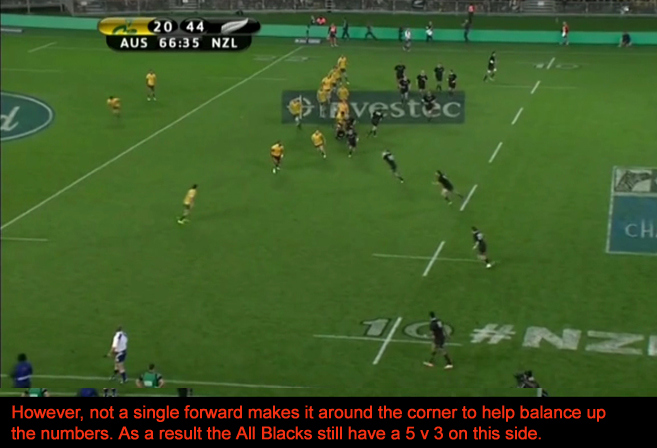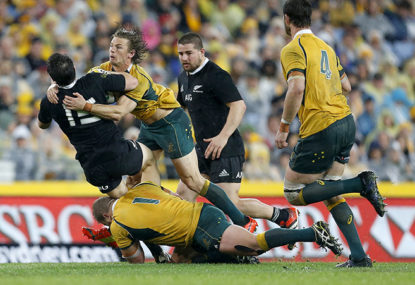The All Blacks played really well to humble the Wallabies in Bledisloe 2 on the weekend. Despite some hoping they may be coming back to the field, they showed they are still clearly the number one team in the world.
I said last week that I was concerned that they never seem to play two poor matches in a row and were likely to turn in a great performance in Auckland. The Wallabies performance on the other hand regressed significantly.
Greg Clarke made the comment towards the end of the Fox coverage of the match that the Wallabies have to start sorting out their selections and tactics now to be ready for the 2015 Rugby World Cup. I actually think we need to focus a little more on the short term – the next match against South Africa in two weeks and what can be done to make improvements for that match.
There are obviously selection issues which have been discussed in numerous articles but regardless of who is selected, the number one priority has got to be sorting out the defensive performance.
If you’ve had a chance to watch my analysis video from yesterday you’ll have seen some of the issues in defence that need to be addressed. If not, the video can be accessed above.
In defence there are five key issues to work on.
- Alignment – players have to work hard to get in the right position so that all opposition players are covered. Whether a team is using an up and in defence system; an up and out system; a sliding defence system or a straight up rush defence is irrelevant because no system works unless players get in the right position in the first place;
- Maintaining the line – if the defensive system calls for a straight up rush all the players have to rush together. If the system calls for a push out, all players have to push out together. The moment you have different players doing different things your defensive system will fail, no matter how good the players you have in the team. If that means one player has to sacrifice some line speed to maintain a single wall of defence, so be it. Of course the players should then make sure that next time they go up faster together;
- Adjustments on the run – the defensive line has to be able to adjust based on what the opposition are doing. It’s no good having a great defensive system and sticking to it if the opposition adapt and do something unexpected;
- Points 2. and 3. rely on good communication between the players and trust between them. If a player outside trusts the player inside to make the tackle they won’t feel the need to jam in and open up space on the outside;
- Individuals making the tackle.
The performance on Saturday was simply unacceptable and the main issue wasn’t the number of missed tackles because a lot of those occurred with players scrambling back trying to clean up issues created by the front line not even being in position to try and make a tackle. The issues in this match were with points 1. to 4. above.
I counted fifteen occasions in the match where the All Blacks had a significant overlap on the Wallabies out wide during general phase play.
Some of that is caused by the Wallabies hiding Kurtley Beale in defence because quite often he’s positioned as a second sweeper in behind the line. As a second sweeper he’s not in a great position to launch a counter attack so I don’t believe the decision has been taken based on attack.
On other occasions his place in the line is taken by one of the wingers and on those occasions the system doesn’t necessarily cause a shortage of numbers as long as the wingers remember to move up into the line and get there quickly enough.
While this tactic can work at Super Rugby level, as it has for the Reds and Waratahs in their title winning seasons, in my opinion it doesn’t work at international level and the experiment must end. Players should defend in the front line and if their defence isn’t good enough to do that then they shouldn’t be selected.
The bigger issue with being caught short in numbers is players not working hard enough to realign. The following images a number of phases in succession where the Wallaby players failed to address a mismatch in numbers by working harder to move across the field.
 The All Blacks didn’t use the width on this phase preferring to punch the ball up in mid-field. Had they played wider the Wallaby backs would have had to ‘jockey’ out which would have conceded a lot of ground to cover the lack of numbers.
The All Blacks didn’t use the width on this phase preferring to punch the ball up in mid-field. Had they played wider the Wallaby backs would have had to ‘jockey’ out which would have conceded a lot of ground to cover the lack of numbers.
The All Blacks kept up a cracking pace throughout the match and on this occasion popped the ball up off the ground after the tackle denying the Wallabies any chance to slow the ball at a ruck.
Obviously the forwards were tied up in the lineout at the start of that first phase but they needed to work hard to fold from inside where the tackle was made to the outside which would have allowed the backs to spread wider and match up the numbers.

Who should have made it around the corner? At least one of the backrow had to get there and none of them were involved in the mid-field tackle so they should have been available. Yes, they were involved in the driving maul from the lineout but they simply had to work harder to get across the field.
In this next segment of play the All Blacks do move the ball wider and the Wallaby backs ‘jockey’ across and back, conceding territory to avoid conceding a line break. This was the right way to defend the overlap but it is a very passive defence and gave the All Blacks good front foot ball.

The All Blacks straightened the attack up and tried to go in between the defenders rather than around them.

While none of the Wallaby forwards made it around the corner at this ruck, Keiran Read did and he received the ball from Aaron Cruden before helping to create the space outside.
The speed at which the All Blacks played over these couple of phases was phenomenal and by this stage the game was well and truly lost but if the Wallabies are to compete against the All Blacks they are going to have to show more urgency in situations like this.
My final example today involves a quick video snippet to again emphasise how disjointed the Wallabies defence was.
In this instance the Wallabies started with a good, straight defensive line but as Conrad Smith passed to Cruden, Sekope Kepu started backing away for some inexplicable reason.
Then Beale ran in as though he was coming in to the line so Kepu backed off further and moved wider. However, Beale stopped moving forward and let Cruden run.
Wycliff Palu was outside Kepu and he got ahead of the line and seemed to be trying to stop the pass rather than make a tackle.
The defensive line was all over the place and Cruden simply ran in behind Palu and passed to Owen Franks who had been left unmarked.
While the cover got across and tackled Franks, the ball should never have got to him in the first place. A well organised defence would have moved forward and tackled Cruden as he received the pass from Smith.
The mess the Wallabies got themselves into here was indicative of how they defended for most of this match.
Is the issue one of coaching? I doubt it – does anyone seriously believe that the coaches are asking players to defend like this?
Are the coaches pointing out these errors to players? I’m sure they are but should they really need to fix players at the international level? They shouldn’t but obviously have to which takes time away from other important areas.
Are these technical issues or do players either not trust the defensive systems they’re meant to work within or don’t trust their team mates to make tackles? I think it’s probably more a mental issue of a lack of confidence and a bit of panic.
Regardless of what the issues are they must be fixed and in the short term.

































































































